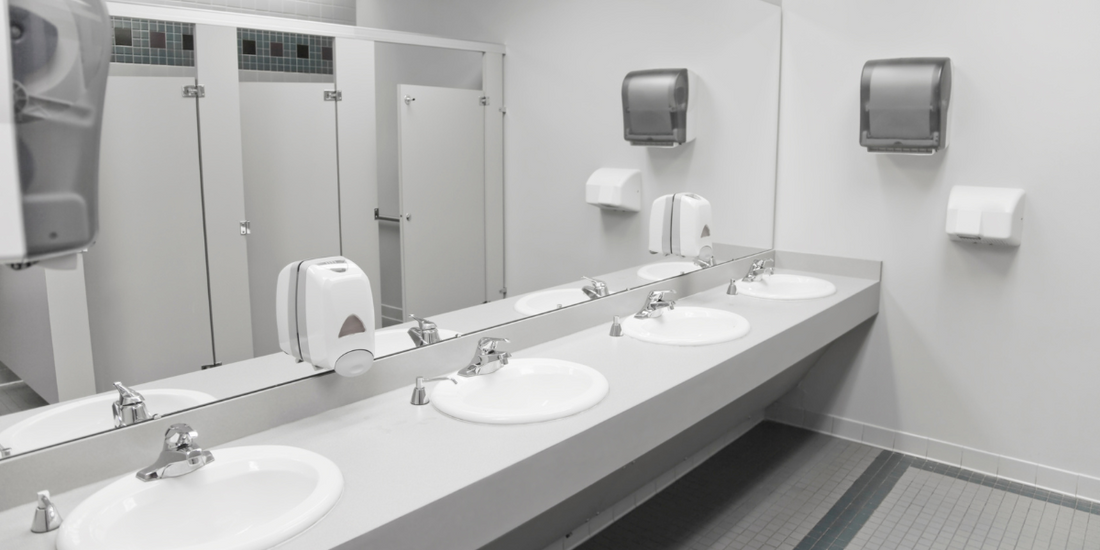
Commercial Bathroom Ventilation: What Businesses Need to Know
Share
Proper ventilation in commercial restrooms is crucial for maintaining air quality, ensuring compliance with building codes, and providing a comfortable environment for employees and customers. Whether you operate a restaurant, office building, hotel, or retail store, understanding the essentials of commercial bathroom ventilation can help you avoid health risks, unpleasant odors, and costly compliance issues.
Why Commercial Bathroom Ventilation Matters
- Improves Air Quality Poor ventilation leads to lingering odors, excessive humidity, and the buildup of airborne contaminants such as bacteria and mold. A high-quality commercial exhaust fan helps maintain fresh air by removing unwanted pollutants and ensuring proper air circulation.
- Prevents Mold and Mildew Growth Bathrooms are naturally humid environments, making them prime locations for mold and mildew. Without an effective exhaust fan, moisture accumulates on walls, ceilings, and floors, leading to costly damage and potential health hazards.
- Ensures Code Compliance Many local and national building codes require commercial restrooms to have adequate ventilation. Non-compliance can result in fines, legal issues, and difficulty obtaining business permits.
- Enhances Customer and Employee Experience No one wants to use a restroom that smells bad or feels stuffy. Proper ventilation improves comfort, leading to a better experience for both customers and employees. For businesses such as restaurants, hotels, and office spaces, this can impact customer satisfaction and employee productivity.
Key Factors to Consider When Choosing a Commercial Bathroom Fan
1. CFM (Cubic Feet per Minute) Requirements
The first step in selecting a commercial bathroom exhaust fan is determining the appropriate CFM rating. CFM measures how much air a fan can move per minute. The larger the restroom, the higher the required CFM.
- Small commercial restrooms (1-3 stalls): 150-250 CFM
- Medium-sized restrooms (3-5 stalls): 250-500 CFM
- Large public restrooms (5+ stalls): 500+ CFM
For high-traffic areas such as shopping malls, airports, and stadiums, a high-powered ventilation system with multiple exhaust fans may be required.
2. Noise Level (Sones Rating)
Excessive noise can be disruptive in professional settings. When selecting a fan, consider- Quiet operation: 1-2 sones (Ideal for office buildings, hotels, upscale restaurants)
- Moderate noise 2-4 sones (Suitable for retail stores, mid-range restaurants, schools)
- Louder operation: 4+ sones (Common in industrial and high-traffic restrooms)
3. Energy Efficiency
Choose a fan that meets or exceeds Energy Star-ratingscan significantly reduce energy consumption and operating costs. DC motor fans, like those offered by Sterling Bathroom Fans, provide longer lifespan, quieter performance, and lower energy use compared to traditional AC motors.
4. Additional Features to Look For
- Motion and Humidity Sensors Automatically turn the fan on when moisture or movement is detected, reducing energy waste.
- Built-in LED Lighting: Ideal for facilities where additional lighting is needed.
- Delay Timer Function Ensures ventilation continues after occupants leave the restroom, improving air circulation.
- High-Capacity Ducting Opt for 6” or 8” ducting for commercial fans to improve airflow efficiency.
Installation Best Practices for Commercial Bathroom Fans
1. Proper Fan Placement
-
Install fans near showers, toilets, and urinals to remove moisture and odors effectively.
- In larger restrooms, use multiple fans to ensure even air circulation.
- Place fans at least 3 feet away from air conditioning or heating vents to prevent airflow conflicts.
2. Ductwork Considerations
- Use rigid ductingrather than flexible ducts to reduce airflow resistance.
- Ensure ductwork extends to the outside of the building, not into attics or crawl spaces, to prevent mold buildup.
- Keep ducts as short and straight as possible to maximize efficiency.
3. Regular Maintenance is Key
- Clean fan grilles and blades every 3-6 monthsto prevent dust buildup.
- Inspect ductwork annually for blockages or leaks.
- Replace fans every 5-10 years depending on usage and performance.
Commercial Bathroom Fan Recommendations
1. High-Capacity Ventilation Fans
- Best for: Large restrooms, malls, hospitals, schools
- Features:500+ CFM, high static pressure capability, durable galvanized housing
2. Low-Profile Energy-Efficient Fans
- Best for:Office buildings, hotels, fine dining restaurants
- Features: DC motor for energy savings, ultra-quiet operation, sleek design
3. Smart Fans with Motion and Humidity Sensors
- Best for: Retail stores, mid-sized businesses, gyms
- Features: Automated operation, energy-efficient, adjustable speed settings
The Last Word
Commercial bathroom ventilation is not just a matter of comfort—it’s a necessity for health, compliance, and customer satisfaction. Investing in a high-quality exhaust fan tailored to your business needs ensures a clean, odor-free environment while meeting legal requirements.
Looking for top-tier commercial bathroom fans? Check out Sterling Commercial Bathroom Fans for high-performance, energy-efficient solutions built to last.
